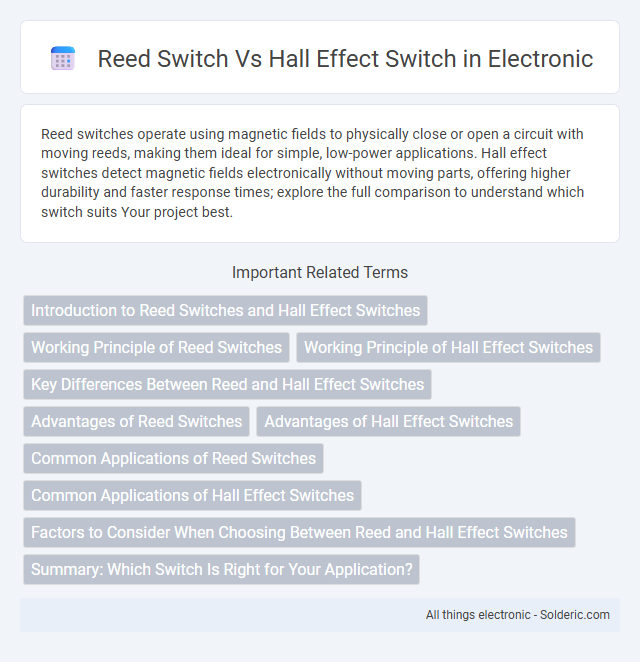Reed switches operate using magnetic fields to physically close or open a circuit with moving reeds, making them ideal for simple, low-power applications. Hall effect switches detect magnetic fields electronically without moving parts, offering higher durability and faster response times; explore the full comparison to understand which switch suits Your project best.
Comparison Table
| Feature | Reed Switch | Hall Effect Switch |
|---|---|---|
| Operating Principle | Mechanical magnetic contact | Solid-state magnetic sensor |
| Durability | Limited by mechanical wear | High, no moving parts |
| Switching Speed | Slow (milliseconds) | Fast (microseconds) |
| Power Consumption | Passive (no power needed) | Active (requires power supply) |
| Output Type | Simple open/close contact | Analog or digital output |
| Size | Typically larger | Compact, integrated circuits |
| Cost | Lower cost | Generally higher cost |
| Magnetic Sensitivity | Moderate sensitivity | High sensitivity, adjustable |
| Environmental Resistance | Sensitive to shock and vibration | Resistant to shock and vibration |
| Typical Applications | Simple on/off position sensing | Precision position sensing, speed detection |
Introduction to Reed Switches and Hall Effect Switches
Reed switches operate using two ferromagnetic contacts sealed within a glass envelope that close or open circuits in the presence of a magnetic field, offering reliable, contact-based switching with low power consumption. Hall effect switches utilize the Hall effect principle, detecting magnetic fields via voltage changes across a semiconductor, providing solid-state, non-contact switching with faster response times and enhanced durability. Both devices serve crucial roles in magnetic sensing applications, with reed switches favored for simplicity and cost-effectiveness, while Hall effect switches excel in precision and integration into electronic systems.
Working Principle of Reed Switches
Reed switches operate based on the magnetic attraction between two ferromagnetic reeds enclosed in a glass capsule, closing the circuit when exposed to a magnetic field. The reeds move due to the magnetic flux generated by an external magnet, enabling or interrupting electrical contact without physical contact or power consumption. This contactless switching mechanism offers high reliability and low power usage, distinguishing reed switches from Hall effect sensors, which detect magnetic fields via semiconductor elements.
Working Principle of Hall Effect Switches
Hall effect switches operate based on the Hall effect phenomenon, where a voltage is generated perpendicular to the current flow in a conductor subjected to a magnetic field. This voltage output changes in response to the magnetic field strength, triggering the switch without physical contact. Compared to reed switches, hall effect switches provide faster response times, higher durability, and precise digital or analog output signals for magnetic field detection.
Key Differences Between Reed and Hall Effect Switches
Reed switches operate using magnetic fields to physically close or open contacts, offering simple, reliable switching with low power consumption. Hall effect switches detect magnetic fields electronically, providing non-contact sensing, faster response times, and higher durability in harsh environments. Your choice depends on application needs: reed switches suit low-current, cost-sensitive uses, while Hall effect sensors excel in precision and long-term reliability.
Advantages of Reed Switches
Reed switches offer significant advantages such as low power consumption, simple construction, and excellent reliability in detecting magnetic fields without the need for an external power source. Their hermetically sealed design ensures high resistance to environmental factors like dust, moisture, and vibration, making them ideal for harsh or industrial applications. You benefit from their long lifespan and minimal electrical noise, which ensures precise and stable switching performance.
Advantages of Hall Effect Switches
Hall Effect switches offer precise, contactless operation with high durability and reliability, making them ideal for harsh environments. They provide fast response times and can detect magnetic fields without physical wear, ensuring longer lifespan compared to reed switches. Their immunity to vibration and shock enhances performance in automotive and industrial applications.
Common Applications of Reed Switches
Reed switches are commonly used in security systems as door and window sensors due to their reliable magnetic field detection and low power consumption. They are also widely applied in reed relays for telecommunications and in automotive systems for position sensing, benefiting from their simple design and durability. Your choice of a reed switch ensures precise contact closure in applications requiring straightforward magnetic actuation and minimal electronic interference.
Common Applications of Hall Effect Switches
Hall effect switches are widely used in applications requiring precise position sensing, such as brushless DC motor commutation and automotive crankshaft or camshaft position detection. These devices also serve critical roles in proximity sensing within industrial machinery and consumer electronics like smartphones for cover detection. Your projects can benefit from their non-contact operation, high durability, and immunity to dust and debris, making them ideal for harsh environments.
Factors to Consider When Choosing Between Reed and Hall Effect Switches
When choosing between reed switches and Hall effect switches, consider factors such as durability, sensitivity, and operational environment. Reed switches offer reliable contact operation in simple magnetic field detection, while Hall effect switches provide solid-state performance with higher precision and resistance to mechanical wear. Your application's need for longevity, response time, and environmental exposure will determine which switch type optimizes functionality and reliability.
Summary: Which Switch Is Right for Your Application?
Reed switches excel in low-power, simple on/off applications, offering reliable performance in magnetic field detection without requiring power to operate. Hall effect switches provide precise, variable output and faster response times, ideal for digital control systems needing continuous position or speed sensing. Selecting the right switch depends on factors like operating environment, power availability, sensitivity requirements, and signal output preferences.
reed switch vs hall effect switch Infographic

 solderic.com
solderic.com